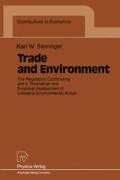Abstract
Trade and environment issues are interwoven in various ways. Before entering into any analysis this chapter first categorizes the interlinkages. For illustration it also gives details of selected recent cases of international awareness.
Access this chapter
Tax calculation will be finalised at checkout
Purchases are for personal use only
Preview
Unable to display preview. Download preview PDF.
References
The overview of the case draws on U.S. Congress (1992), p. 89; an early reference is “Freedom to be Cleaner Than the Rest,” The Economist, October 14, 1989.
GATT Trade Negotiations Committee (1991), commonly “Dunkel draft”, in its proposals on the Sanitary and Phytosanitary Standards (commonly SPS Code), p. L.46, paragraph 3.
Arden- Clarke (1991), pp. 27–28; and as cited in U.S. Congress (1992): Wysham (1990), pp. 770–73; Hillard (1991), pp. 27–28.
GATT Multilateral Trade Negotiations (1994), p. 69; see Annex A definitions, p. 77.
For an evaluation of the harmonization approach in detail see Steininger (1994), also comparing the case of harmonization for product regulation, which is promising, with the one of process regulation in view in this section.
Uimonen and Whalley (1994 forthcoming (fall), draft 1991), pp.22.
U.S. Congress (1992), p. 40, based on Pagel, Mark and Ruth Mace (1991), Keeping the Ivory Trade Banned, Nature, vol. 351, May 23, pp. 265–66 and on Aldous, Peter (1991), African Rift in Kyoto, Nature, vol. 354, November 21, pp. 175.
GATT Secretariat (1992), p. 21: “It is often a challenge just to get a critical mass of countries - let alone all countries - to participate in an international environmental agreement. [..] Trade measures could be used as one type of ‘carrot’ or [..] as one type of ‘stick’ to encourage participation.”
Hoel (1992a), section 9. For the case of significant CO2 reduction targets he, as most economists, also objects to the uniform reduction schemes arguing not only on the grounds of economic inefficiency, but also on the then only low incentive for sufficiently large participation, “since such a scheme gives a distribution of costs of reducing emissions which may differ strongly from the advantages the countries have from avoiding climatic changes.”
Author information
Authors and Affiliations
Rights and permissions
Copyright information
© 1995 Physica-Verlag Heidelberg
About this chapter
Cite this chapter
Steininger, K.W. (1995). The Issues of Interlinkage. In: Trade and Environment. Contributions to Economics. Physica-Verlag HD. https://doi.org/10.1007/978-3-642-49342-3_2
Download citation
DOI: https://doi.org/10.1007/978-3-642-49342-3_2
Publisher Name: Physica-Verlag HD
Print ISBN: 978-3-7908-0814-8
Online ISBN: 978-3-642-49342-3
eBook Packages: Springer Book Archive

